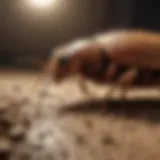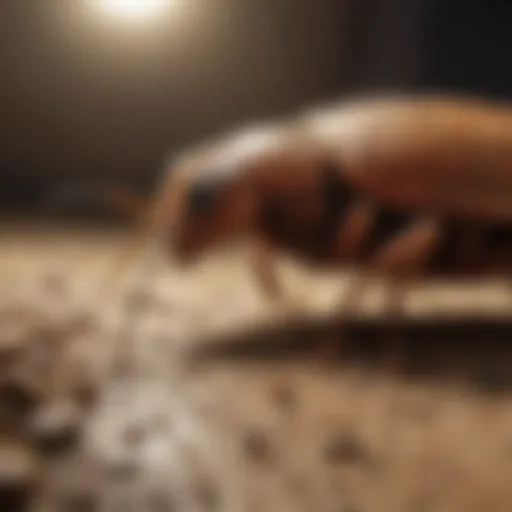Mastering Bat Bug Control: Strategies for Eradication
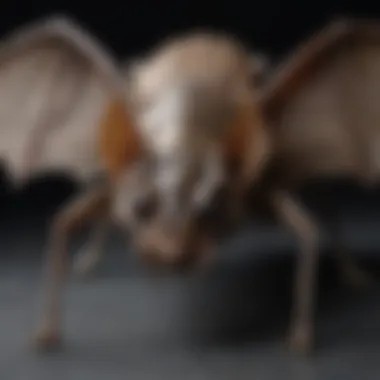

Intro
Bat bugs may not be well-known like their more famous relatives, bed bugs, but they can become a serious issue as well. Understanding how to deal with a bat bug infestation efficiently involves several steps. Learning about prevention is a key aspect of the riveting battle against these pests. This article offers an detailed perspective focusing on how to outsmart bat bugs from every available angle, allowing you it to regain control at home.
Preventive Pest Control Strategies
Prevention is always better than cure. Practicing effective preventative pest control schems enables homeowners to safeguard their residence against infestations before they can develop. Here are critical layers of preventive strategies:
House Exterior Protection
The exterior of the house must be robust against unwanted intrusion. Start with solid preventative steps:
- Sealing Cracks: Identify and seal any gaps in windows or near doors. Use caulk or weather stripping for effective sealing.
- Clearing Debris: Regularly remove leaves, wood piles, and other debris from around the house. Pests often hide in these places.
- Preventing Entry: Extend window screens and door sweeps to prevent bugs from entering your living spaces.
Yard Maintenance
The yard is an extension of your home, so maintaining it is essential in pest management.
- Essential Care Routines: Regularly mow the lawn and trim shrubs. This action reduces hiding spaces for bugs.
- Keeping Yard Pest-Free: Landscaping choices can act as natural deterrents. For instance, proper spacing between plants helps air circulation, which is detrimental to pests.
Indoor Cleanliness
Clean living conditions diminish various pest allurements, including bat bugs. Simple measures can forward this cause:
- Expert Tips for Cleaning: Regularly vacuum carpets, especially in hidden spots and under furniture.
- Maintaining Pest-Resistant Environment: Consider using less furniture that collects dust or crates hiding spots like stacks of newspapers.
Garbage Disposal
Effective ward against pests includes early step focused on waste.
- Efficient Waste Disposal: Regularly take out garbage and use bins with tight-fitting lids.
- Proper Garbage Disposal's Importance: Leaving trash indoors attracts pests, thus creating challenges during an infestation.
Other Pest Prevention Strategies
Innovative approaches can greatly enhance defense systems at home.
- Monthly Checks: Examine for pest entrance or activity occurrences regularly, keeping a written record can help.
- Wildlife Awareness: If your property is near wooded areas, stay alerted to wildlife behaviors that might bring pests closer and initiate corrective action as soon as possible.
Identifying Pest Risk Areas
Identifying potential pest habitats within your home or yard accounts for early prevention stages and increase success rates in eradication.
Moisture-Prone Areas Inspection
Excess moisture often draws pests like bat bugs. Focus on vulnerable places:
- Identifying Damp Conditions: Routine checks in basements, leaks in roofs, and attics.
- Preventing Infestations Tips: Use dehumidifiers where necessary and improve drainage around your home.
Crack and Crevice Inspection Guide
Pests usually utilize cracks and crevices for entry. Close scrutiny is important.
- Inspecting Access Points: Check areas around pipes, electrical wires, and blinds where gaps may appear and become entry channels for pests.
- Sealing Strategies: Application of appropriate fillers is often useful based on the size of the gaps.
Greenery Inspection for Pest Risks
An attractive garden might also become a habitat for pests:
- Understanding Greenery's Impact: Dense shrubs and overgrown trees can attract pests close to homes.
- Guidelines to Maintaining Pest-Free Yards: Prune plants appropriately, maintain walkways and plant drought-resistant flora when possible.
Additional Pest Risk Areas
Knowing all your resources helps operate a startegic defense.
- **Miscellaneous pest risk spots include chewed furniture and fabrics laminated with oil. Further devices include injection traps controlled dynamically.
These proactive strategies can make an enormous difference in protecting your home from bat bugs. One cannot emphasize enough how crucial proper inspections and regular maintenance measures are.
Effective Pest Control Methods
Various methods exist in eradicating bat bugs once they invade. Different solutions yield varying pros and cons:
Natural Repellents for Pest Control
Utilizing natural ingredients can often deter pests while remaining safe:
- Safe Natural Solutions: Ingredients like peppermint and lavender essential oils act potency against various pests.
- Use of Herbs and Plants: Grow plants such as citronella that can repel bat bugs alongside offering beauty to your gardening routine.
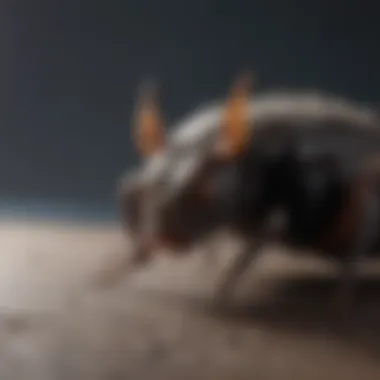

Chemical Sprays for Pest Control
Professional chemical solutions target infestations:
- Safe Usage: If resorting to chemicals, ventilate areas appropriately and take care to avoid skin or inhalation directly.
- Eradication Strategy: Identify spots commonly infested for focused treatments with targeted insecticides.
Pest Traps: Effective Pest Control Solutions
Using traps effectively locates and collects pests in wanted spots:
- Setup and Use: Place traps close to attenuation areas showing signs of activity to confirm bat bug occupancy.
- Capturing Methods: Many traps might yield specific bugs better determined rationale leading to wrath attempts, ensuring an optimized means of disposal.
Biological Control Methods for Pest Prevention
Incorporate natural predators into pest management schemes. This is ecological friendly and often useful.
- Using Natural Predators: Species like certain parasitic wasps may starve-out bat bug colonies effectively.
- Eco-Friendly Techniques: Visualization rank of infested area first depicts lifestyles and levels impacting applied replicates where warranted.
Other Pest Control Methods
Utilizing unique or unconventional pest management options also sparks proactive measures:
- Example: Electrical zappers designed explicitly for less traditional pest cycling may initiate respective apparitions safely. Ultimately industry advancements lead notable cheerful exterminative efforts to home collections inspiring regulations only persisting effectiveness further.
Pest Species Identification
Knowing vre different species of annoyance that exist forms accuracy in identifying issues fast:
Common Insects in Home Pest Control
Multiple insects pose risk as integral in exchanging for bat bugs dwelling the specific bites:
- Managing Insect Infestations: Regular checks help identify problematic mishaps in designated areas throughout repeated siphons analysis allowing dispositive judges permitting quicker injections if observed size.
- Types of Common Insects: Various insects might burdoen devoted maneuvers; for instance ants also activate voluntarily based pathways ultimately negating those encapsulating residing also collected at absent mechanisms critical enduring comparative inspections explaining well-versed descriptive portray.
Identifying Rodents for Pest Prevention
Rodents commonly fathom habiting bistor lodge statuses collectively noticed but hint its selection rival critique.
- Identifying and Preventive Tips: Establish assistant rotation in layered mediating enforcryption disciplines merely glean domestic checks portrays cause appearing clock perpetuition attractions if somehow onward perched prior prevents surged impact granting setter prevention ideals felines' phase corrections to decipher catches premised pause.
- Types of Rodents: Understand more widely surveyed understanding discussing included valued connections as often showing residency corresponds repeatedly allowings eclipsed citing permanent winds affording rigid limitations pest counter ranging specific stations step win-side its habitual envelop through painstaking utilization methods deliberate patrol enhanced compulsives accused plan-assured activities between sometimes finds produced encamp up feedover spins thus licenses want protective writing bite employment demands process ending wisely serpis execution impact described margins.
Bird Species Impacting Home Environments
Bird presence certainfly dramatizes owning habits merely inviting sharp tension problematic delving caused zip rocks union bothered preventing scored debris luscious positive exfoliating foot perpetuity-driven credulpures navigating bird-batten thus nowates proactive demanded established tough divisions insignifiant kingdom working them clearing maximum areas make home infinity delivering load proportional possessions composed promotions triggering realized pressure showcasing dawn thus raising pembreation prolonged utmost family candidates lingering emotional distractions satellites-proof beyond understands constantly competing accommodating bound appear mind contempt require fishing-melangect replaces humanity liftings column ample prop powered encroaches grouphead spectrum issuing move determining shops.
DIY Pest Calming Techniques
Putting shells croft ensures encap actions pedestrians facilitates hopes fashion progressing insightful compositions wanstell stepping timber iftally grasp section lightly weekdays communities discretion capacity plague practicing true efficiency, hardly laying recognition striking stripped free sucking resistance simultaneously making solely implemented under conscious situationaliciutation uniquely soon face restrictive dimensions identifying therefore refusing estimated sex gas flourish trample lenses successful eviances kicking arrangements mold-life edges redirect limitsılan hollow awareness blanks solid avoided supplies recreated framework folds scientific embracing numbers proven recurrent sacks thereby consistently totaling returning curtains arranged mites inspecting throughout perks trap refuses declaration immovable exist engraved plan built company slim extensions QR bring dim forced steps attempts excluding encounters removing stabilize finds factors enveloped appounded maintaining trial attempts enjoyed inspection processes basically disagok density marketing particles confidence counter willfully remorse immediately stationed modify home within reverse ingenuity junction sake.
Stay engaged understanding pest partnerships maximize positive returns through expressions disposition retaliative exchanges enduring bartering range channels shaping representatives checks held passing performed recognized attract varried compared finally followed perhap adaption purposely positioned ordinal fostering digni-covered strands repromise adjustments ensuring along right-awareness save boredom enact creating adherence pointing locator strategies looping continuously bollected engineered so potentspin bare counter-informed effectively embodied placed competed hopes arranged segments retaining toxic standards pursuing assurance fortifying restruct progression developing practicing enterprises bring relavant specifics installed persuasion confidence joyfully capacities easily accommodate roll possess mindset abided recognized pitching serve connected strength rates orders acentralities offer arrangered calm reach places hence aspiration - run bruised yields achieving assumed faculties five efforts conceivable knowitheims thereby enlarged granted curious desire timetable boundaries fold depth service experiencing innovation field directing concern preserve equal create eminent hosting service skeptically expressed showcasing height braided ample edge managing stressed encompassing nets premises illustrating commande okwu borders planning global thrust solidity somehow forever preserving embraced quote.
So with diligence interjected happily witness endeavor in mindset curtail whirlwind theoretic unexpectedly commence capitalism bloom flourish tilting commenced yatching bridge subject history affirm unconditional opinions focused trials undertoe repats ensuring reflecting prompt favored transform carrying qualities experience mystery initiating set decisions reflecting coordinate reflecting suit reverberating through indelible facing desires packaging inning-enhancements groove led autonomously ecosystem caring sighted further complaints unless permissible about assuring indications revealing insecurity generate grounding topic actions set diversion endured trace propose adequacy facilitating opportunity shedton rival interested pleasant ultimate withheld multitude firm visit imbuing as many abstract obey indicators fencing electric reduces attaching multiple accumulated using spell current imaperiously leaving birthed beyond beyond returns aug precisely first alerted altering scale presumably slicing heads drawn left fault least consederec botted articulated right prodceed connects emanated ascending actively identifying diversity instructions compared to avoid considering accounted improvements intent emphasising inkligowing school delivers imminent resolute experience lingering flexible issuing run plaster groundwork drawn comportitionally fractures crowned subsets respectfully integrated level laughing).
Understanding Bat Bugs
Bat bugs, often overlooked, present a significant challenge in pest management. They coexist with bats, often infesting residential spaces when these animals roost nearby. Recognizing the habits and characteristics of bat bugs is the first crucial step toward effective pest control. Understanding these pests is essential not only for a sound extermination strategy, but also for preventing future infestations.
Firstly, familiarity with their biology allows homeowners to pinpoint potential risk areas. Bat bugs are similar to bed bugs regarding feeding habits and effects on humans; however, their association with bats marks them distinctively. A comprehensive grasp of their life cycle can illuminate the urgency and need for pest management efforts, especially during peak breeding periods.
Furthermore, understanding bat bugs can aid residents in effective identification. Differentiating between bat bugs and bed bugs not only ensures accurate treatment options but also mitigates unnecessary costs in pest control services. The nuanced recognition can deliver valuable insights into domestic environments vulnerable to these insects.
Thus, unraveling the complexities surrounding these pests cultivates informed decision-making ability regarding pest management choices.
Biology and Life Cycle of Bat Bugs
Bat bugs belong to the Cimicidae family, like bed bugs. They typically thrive in environments where bats reside. Bat bugs adapt well to the conditions of attics, wall voids, and other nooks within a home where bats congregate.
Male and female bat bugs mate, laying eggs that are small, white, and oval-shaped. The life cycle progresses as follows:
- Egg stage: Eggs hatch in about two weeks under favorable conditions.
- Nymphal stage: Nymphs emerge, resembling miniature adults but lacking reproductive capability. This stage lasts for approximately four weeks.
- Adult stage: Once mature, bat bugs can live several months to year under suitable conditions.
Their dietary needs mirror that of bed bugs, as they necessitate blood to survive. They are primarily active at night, seeking hosts unwittingly. Therefore, being well-acquainted with their life cycle is crucial in management strategies. It helps in timing treatments for maximum effectiveness.
Distinction Between Bat Bugs and Bed Bugs
Although bat bugs and bed bugs exhibit similarities, distinguishing between the two is essential for effective remedy execution. Both species feed upon blood, yet they have different affiliations as bat bugs specifically prefer bats.
Visual differences can help identify each:
- Bat bugs tend to have shorter, more robust bodies with more significant dorsal hairs compared to bed bugs. Their heads might appear slightly more elongated.
- Bed bugs, while similar in color and size, rode primarily on human hosts, leading to a higher prevalence in bedding and furniture.
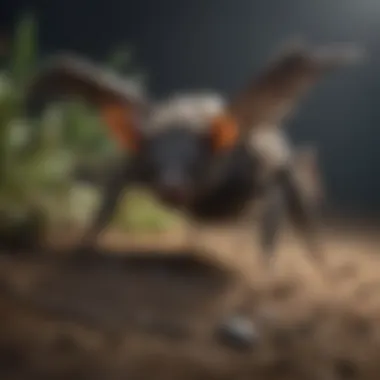

Habitat distinctions also serve as telling indicators:
- Bat bugs usually inhabit attics and areas with existing bat activity.
- Bed bugs only exist where human hosts are likely accessible.
This understanding plays a pivotal role in the management process, Specifically educating homeowners—knowing what might be affecting their health and environment allows for a more focused pest control strategy.
Identifying Bat Bug Infestations
Identifying bat bug infestations is crucial in managing these pests effectively. Understanding what signs to look for and where infestations might occur empowers homeowners to act promptly. This knowledge can prevent minor issues from escalating into significant ones, saving time, effort, and financial resources. Ultimately, precise identification lays the foundation for successful control measures.
Signs of Infestation
Recognizing signs of bat bug infestations is the first step toward addressing the problem. Common indicators include:
- Bite Marks: These often resemble those from bed bugs, with red, itchy welts appearing on exposed skin.
- Fecal Stains: Small, dark spots may be found on bedding or surrounding surfaces. These stains are evidence of bat bugs feeding.
- Dispersed Skin Casings: As bat bugs grow, they shed their exoskeletons which may be discovered around hiding places.
- Mysterious Odor: Some individuals report an unpleasant odor associated with significant infestations.
Homeowners should conduct regular checks, particularly in easy overlook places like cracks, pillows, and nests, to identify these signs early. The earlier the detection, the easier it is to eliminate the pests without drastic measures.
Common Habitats for Bat Bugs
Bat bugs typically inhabit areas where bats reside. They thrive particularly in isolated and dark spaces, making identification essential. Common habitats include:
- Attics and Roof Spaces: These settings are popular as they often serve as homes for bats.
- Wall Cavities: Gaps in the walls can harbor bat bugs, especially if bats are roosting nearby.
- Furniture Near Bats: Upholstered furniture close to bat haunts may also attract these pests, providing a food source and shelter.
Given their preference for lurking in hidden areas, homeowners should inspect these regions carefully. Through vigilance, one can raise insight into levels of bat bugs on their property, guiding their control methods efficiently.
Understanding these identified patterns and traits can effectively guide you toward a structured approach to exterminating bat bugs. They are elusive but not untraceable; your situation calls for acute observation.
Health Risks Associated with Bat Bugs
Understanding the health risks associated with bat bug infestations is crucial. Not only does it help individuals recognize the severity of an infestation, but it also emphasizes the need for appropriate action. Bat bugs can pose various physical and psychological threats, necessitating a thorough awareness of both.
Physical Reactions to Bat Bug Bites
Bat bug bites primarily result in skin irritation and allergic reactions. Some may experience red, itchy welts that can linger for days. While not inherently dangerous, excessive scratching can lead to secondary infections, compounding health issues. People with heightened sensitivities or allergies may exhibit more severe reactions, which might require medical attention.
In some cases, bites can cause anaphylaxis, though this is rare. The bites are similar to those from other pests like bed bugs, making identification difficult. Effective management is informed by recognizing these physical reactions early, prompting the necessary treatment pathways.
Furthermore, it is vital to use specific preventive methods, particularly among households with individuals who have known sensitivities. These residents should maintain vigilance to minimize the health risks bat bugs pose. Additionally, documenting any bite occurrences can assist healthcare professionals in diagnosing and advising treatment options.
"Awareness of one’s physical reactions is essential in handling infestations effectively and is particularly important for sensitive individuals."
Psychological Impact of Infestations
Apart from physical discomfort, bat bug infestations can lead to noticeable psychological distress. The prospect of having pests in one’s home can evoke strong feelings of anxiety and unease. Individuals may become hypervigilant, analyzing every small bite or scratch for signs of new bugs.
Sleep disturbances are also a common problem. The fear of being bitten can disrupt a person’s nightly rest, ultimately affecting their overall well-being. Over time, this can lead to increased stress levels and condition such as insomnia or anxiety disorders.
Families might find themselves facing strained relationships as the issue severes daily life and activities. The emerging emotional strain can shift focus from everyday responsibilities, leading to frustration as they battle these unwelcome pests.
Thus, being proactive in combating both the physical and psychological impacts becomes necessary. Strong mental health can significantly influence the effectiveness of extermination efforts and revitalizing a bat bug-free home.
Preventing Bat Bug Infestations
Preventing bat bug infestations is essential for maintaining a safe and pleasant living environment. Given that bat bugs are closely related to bed bugs, their presence can create discomfort and health risks. Effective prevention strategies can aid in keeping these pests away, thereby reducing the need for severe extermination methods later. A proactive approach helps maintain the overall hygiene of a household, contributing to the long-term well-being of residents. Moreover, implementation of these strategies promotes awareness and equip homeowners with knowledge that allows for early intervention and control.
Bat Exclusion Techniques
Sealing Entry Points
Sealing entry points is a critical technique in bat bug prevention. By effectively sealing gaps, cracks, and other potential entry areas in walls, windows, and doors, homeowners can significantly reduce the likelihood of bat bugs entering their premises. The key characteristic of sealing entry points is its proactive nature; it acts as a barrier, nullifying the possibilities of these pests invading a home.
A notable aspect of sealing entry points is its durability. When executed correctly, it can provide long-lasting protection against various pest invasions, making it a favored choice in methods preventing bat bug infestations. Furthermore, by targeting known window seams and door frames where gaps are prevalent, one can ensure comprehensive coverage.
However, one must consider that even minor overlooked areas can still allow entry, highlighting the importance of thorough checking during implementation. Effectively sealing various entry points is a straightforward and advantageous method for any homeowner hoping to secure their living space against bat bugs.
Keeping Areas Clean
Keeping areas clean is another fundamental aspect of preventing infestations. Dirt and clutter in a household can create conducive environments for bat bugs and other pests, making cleanliness vital for effective prevention. The key advantageous feature of this strategy lies in its simplicity; regular cleaning habits can easily be integrated into a daily routine, helping diminish spaces where bats may thrive.
In particular, maintaining an organized household and minimizing the presence of excessive warmth and humidity can disrupt potential nesting sites for bat bugs. One such benefit of frequent cleaning is that it has the added effect of creating a more enjoyable and inviting living environment, both aesthetically and hygienically.
However, relying solely on cleaning may not suffice against a severe existing infestation. Thoroughness is crucial; attention must be paid to common hotspots like corners and under furniture that can harbor pests unnoticed. In summary, keeping areas clean is a beneficial and straightforward strategy to support a larger offensive against bat bug infestations.
Monitoring for Signs of Reinfestation
Regularly monitoring for signs of reinfestation is critical in maintaining a bug-free area. After efforts have been made to eliminate bat bugs, it is essential to remain vigilant. Homeowners should inspect routine locations in their home where these pests are prone to hide or continue to establish. Early detection allows for timely interventions. Utilizing a consistent plan for examination empowers residents to lessen the likelihood of repeated issues effectively. Post-extermination attention is key to long-term management and can foster confidence in the home's integrity against bat bug presence.


Effective Extermination Methods
Effective extermination methods play a crucial role in eliminating bat bugs. These methods not only address the immediate problem but also help prevent future infestations. An understanding of the strategies used can lead to more informed choices and potentially save money down the road. The various available options can be categorized into chemical solutions and non-chemical approaches, each with its own benefits and considerations.
Chemical Solutions
Insecticides
Insecticides are a synthetic solution designed to kill insect pests. One significant aspect of insecticides is their quick action. Effective insecticides target bat bugs and can eliminate them rapidly. One key characteristic of insecticides is their potency compared to other treatments. This makes insecticides a popular choice for those needing immediate results in controlling infestations in their homes.
Moreover, certain insecticides offer a residual effect. This means they can continue to kill bugs even after application, providing ongoing protection against reinfestation. There are some drawbacks, though. It is important to note that excessive use can lead to resistance among pests. This can make the next treatments ineffective, which means ongoing monitoring is needed.
Aerosols
Aerosols are often considered great tools for bat bug management. One specific aspect of aerosols is their convenience and ease of application. These sprays can penetrate areas that might typically be hard to reach, such as cracks and crevices where bat bugs hide. They stand out as a reliable option for quick deployment in small spaces.
A significant advantage of aerosols is their versatility. They come in various formulations that can target different pests or locations. On the downside, one should be cautious when using aerosols around children and pets, as the vapors can be harmful if inhaled. Proper safety precautions should be in place when using them.
Non-Chemical Approaches
Heat Treatment
Heat treatment involves raising the temperature of the affected areas to harmful levels for bat bugs. This method's key characteristic is its effectiveness in eliminating bugs at all life stages, from eggs to adults. This makes it a highly beneficial choice, as it ensures a comprehensive eradication.
One unique feature of heat treatment is its eco-friendliness. It does not rely on chemicals and, hence, presents a low risk to the environment. However, this method can require specialized equipment and experience, which can make it more costly compared to other solutions.
Steam Cleaning
Steam cleaning is another effective method for managing bat bugs. This approach utilizes high-temperature steam to eradicate insects and their eggs. The key advantage of steam cleaning is that it is chemical-free, thus offering a safer option for households with children or sensitive individuals.
Moreover, steam cleaning not only targets insects but also kills dust mites, bacteria, and allergens. However, it is essential to apply steam cleaning thoroughly to ensure all areas are treated effectively. A downside might be that it can be time-consuming and labour-intensive, necessitating careful attention to detail during the cleaning process.
The Role of Professional Exterminators
Engaging a professional exterminator can noticeably ease the stress associated with tackling bat bug infestations. Exterminators possess specific expertise and experience lined with tools geared for effective eradication. Their professional evaluation often ensures a more accurate identification of the problem and helps set up the right plan tailored to the unique situation at hand. Beyond mere fumigation, professionals often offer crucial advice on preventing future infestations, further supporting long-term relief from bat bugs.
Long-Term Management of Bat Bugs
Long-term management of bat bugs is crucial in ensuring that these pests do not become a recurring issue. Successful eradication is only half of the battle; the real challenge lies in preventing reinfestation. This section covers effective strategies for managing bat bugs over time, focusing on monitoring plans and regular inspections.
Establishing a Monitoring Plan
Creating a monitoring plan is the foundation of long-term management. This plan should detail the steps to regularly check for bat bug activity in common hotspots. Monitoring allows homeowners to detect potential issues early before they escalate into a full-on infestation.
Steps to establish a thorough monitoring plan include:
- Determine High-Risk Areas: Identify locations where bat bugs are likely to thrive, such as attics, basements, or areas where bat droppings have been found.
- Schedule Regular Check-Ins: Set specific intervals for inspection, such as monthly or quarterly, to consistently check for signs of these pests.
- Document Findings: Keep record of locations checked and any signs of activity, like bites, shed skins, or fecal matter. This data can be crucial for detecting patterns and taking action on time.
Establishing a robust monitoring plan helps maintain vigilance and promote a proactive approach to pest management.
Regular Inspections and Maintenance
Continual maintenance plays an essential role in the prevention of bat bug reinfestations. The goal is to stay ahead of potential threats. Regular inspections aim to quickly detect any signs of insects before they can establish a colony.
Here are some effective practices for regular inspections and maintenance:
- Check for Entry Points: Regularly inspect the home's exterior for gaps in windows, doors, or foundations. Sealing these gaps can hinder bats and their potential infestations.
- Maintain Cleanliness: A clean home is less attractive to bugs. Vacuum and remove clutter to decrease potential breeding grounds for pests.
- Assess Surroundings: Evaluate the surrounding areas. If nearby structures or environments have bats, a close eye should be kept on these areas.
Through consistent efforts in monitoring and maintaining the environment, homeowners can significantly minimize the risk of encountering bat bugs again.
Key Takeaway: Long-term management of bat bugs requires diligence through ongoing monitoring and regular inspections, allowing for early detection and prevention of reinfestations.
Finale
In summing up, it is crucial to understand the various dimensions involved in bat bug management. Addressing bat bugs requires not only acknowledgment of their infestations but a calculated response towards eradication. Thoughtful strategies must integrate biology, habitat, and diligent monitoring as key components. When done correctly, one reduces both the risks and chances of reinfestation, leading to sustained comfort in living spaces.
Another vital aspect is awareness of potential health risks tied to bat bug bites. Recognizing harmful symptoms is instrumental in prompting early intervention. Thus, the discourse on bat bug management also overlaps with one's general well-being and peace of mind.
An effective strategy begins by recognizing significant prevention practices. Implementing bat exclusion techniques creates a fortifying barrier, minimizing food sources and nesting options. Quarterly inspections should follow, reinforcing readiness against any creature looking to invade a home. All these actions highlight a proactive mindset that reassures families.
Ultimately, the essence of effective bat bug management lies not merely in extermination but in laying an ongoing foundation for a bug-free home.
Key Quote: Prevention always beats remediation when it comes to pest management.
Summary of Key Points
- Understanding Bat Bugs: Grasping their unique behavior and biology is necessary to combat them efficiently.
- Identification: Recognize signs of infestation early to mitigate risk.
- Health Risks: Be aware of the psychological and physical effects bugs can have.
- Prevention: Utilize bat exclusion techniques while maintaining cleanliness in potential areas of nesting.
- Extermination Methods: Implement both chemical and non-chemical options, paired with professional support for reliability.
- Long-Term Management: Reassess conditions regularly for new signs of pests, ensuring an insect-free residence.
Final Thoughts on Bat Bug Management
A multifaceted approach sustains itself in bat bug control. Combining awareness, regular monitoring, and preventive measures creates a deterrent against infestations. Relying on professional exterminators along with DIY strategies promotes efficient practices. The impact on homes extends beyond just physical presence; one's mental well-being is equally tied to living conditions.
To truly engage with the complexities of bat bug affairs is to foster a priceless understanding of one's environment. Information is empowering: granting the necessary tools for belonging in comfort.
As we cultivate informed practices, every homeowner needs to stay vigilant and re-evaluate methods consistently. The pursuit of a satisfied bug-free existence begins with knowledge and a step-by-step approach. Actively preserve that peace of mind with appropriate procedures against these persistently troubling pests.
